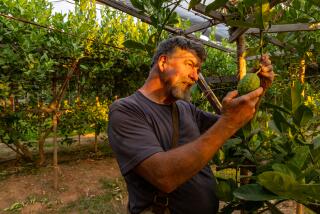In India, lots of coconuts but a dwindling crop of pickers
NEYYATTINKARA, India — Retired government worker and small-time coconut farmer Prakasan Thattari is very proud of his invention: a machine with the look of a giant metallic praying mantis that clangs fearlessly up vertigo-inducing coconut trees.
It climbs well, but has a little trouble cutting off the coconuts once up there, said Thattari, who estimates that he’s gone through thousands of dollars tinkering with various gizmos.
“I spent all my retirement money,” he said. “The machine is close to my heart.”
Here in India’s southern state of Kerala, a lush land known as “God’s country,” coconuts are big business: The state boasts more than 500 million coconut trees, covering 40% of its land. But these days, coconut farmers are finding it increasingly difficult to find pickers, as younger, better-educated workers shun manual labor for more prestigious “chair” jobs.
So in 2009, the state offered a $20,000 prize for the best robotic coconut picker, and since then the praying mantis and more than 400 of its strange cousins have sallied, crawled and grappled forth.
Unfortunately, most failed to climb, broke down or were completely impractical. Some belched diesel or were so heavy that they couldn’t be moved easily over rough jungle ground. Those that climbed weren’t good at cutting the coconuts once aloft. There are now three finalists. (Sadly, Thattari’s invention made it only to the top eight.)
“They all have problems,” said Balsubramanium Giriraj, one of the judges and a mechanical engineering professor at PSG College of Technology in the city of Coimbatore. “I still think you need human beings.”
S. Sathish makes the job look easy: He tucks a machete into his waistband and shimmies spider-like up 60 feet of tree in Neyyattinkara, bringing several coconuts crashing to the jungle floor with a few deft cuts.
He’s been picking part time for three years when he’s not driving a truck. Climbing is tiring, he said, but once you get the hang of it, you can scamper up pretty quickly. Mornings, he explains, are best, before dust settles on the trunks, making them difficult to grip.
He says he can climb up to 50 trees per day at 50 cents per tree.
“I make more money driving,” he said as sunlight danced on his skin through the palm fronds. “But as a picker, I can set my own schedule, don’t have to do late-night runs and can be in the middle of all this nature.”
But Sathish is among a dwindling number of pickers of the human kind, the downside of Kerala’s success. Exact numbers aren’t readily available, but old-timers estimate that available workers have dropped by two-thirds.
The state, with the highest literacy rate in the country at 93%, does a good job educating people, raising their expectations. But it’s short on industry or jobs. The result is ranks of unemployed who wouldn’t think of sullying their hands, even though some coconut pickers earn more than teachers or nurses do.
Even those with limited education and skill become choosy, given the option of construction jobs in the Persian Gulf states, a local stigma against manual labor and Kerala’s left-dominated politics that have long encouraged strong labor unions and food support programs.
“They’re just plain lazy,” said K.P. Peter, a small-time coconut farmer. “They get all sorts of subsidies from the government, don’t show up on time, leave us stranded. There should be a law against such irresponsibility.”
As part of their search for pickers, industry groups have looked to the likes of Thailand and Indonesia, countries that train monkeys to pluck the coconuts. (Understandably, some local workers find the prospect of being replaced by a monkey mildly insulting.)
But the monkeys aren’t quite working out.
“The problem is, the monkeys climb but can’t tell what’s ripe and just harvest everything,” said Sree Kumar, a professor at the College of Agriculture in Kerala’s capital, Thiruvananthapuram.
In a bid to broaden the labor pool, the Coconut Board’s Friends of the Coconut Tree program is trying to recruit women — picking has traditionally been man’s work — older workers and anyone else who dreams of reaching for the fronds.
The board’s six-day Friends course trains people to use climbing devices, allowing even the most uncoordinated workers to get themselves up a trunk, provided they stifle any fear of heights, which can reach 100 feet. (We’re talking a 10-story building.) The climbing devices, in sitting and standing models, cost about $50 and work by ratcheting the rider up the trunk with a foot-powered device. Around for at least 30 years, they were upgraded in 2010 with rust-resistant materials and a revolutionary new feature: a safety belt.
Pickers are taught to identify ripe fruit and fertilize, prune and treat disease in trees. The course also aims to address picker esteem issues. Its 5:30 a.m. yoga sessions may resemble a Zen retreat, but that’s all about giving individual coconut pickers and the profession more R-E-S-P-E-C-T.
Would-be pickers are offered subsidies to help buy a motorbike and coaching on how to save money. The success of the program has other states following Kerala’s lead. There’s even a dial-a-coconut-tree-climber service to match pickers with farmers.
“We offer mind management, give them a sense of dignity,” said Sreekumar Poduval, an engineer with the Coconut Development Board. “Kerala workers are good when they go overseas to work. But in the state, motivation can be a problem.”
For Sasidharan, 50, who uses only one name, the biggest problem with the job is vertigo. He’s been picking for years, but recently completed the Friends course in hope of boosting his income.
“The yoga, money management tips, it was like I was a college graduate,” he said. “I’m more of a sophisticated climber now, which makes my children proud. I feel like I’ve boosted my social status.”
K. Rajan, a grizzled 65-year-old, climbed trees the old-fashioned way for five decades, scaling four dozen trunks a day, seven days a week, and has no interest in courses at this stage. “Coconuts are a gift from the gods,” he said. “When a child is born, we give them coconut milk, and also when someone’s about to die. They give humans great energy.”
Rajan says that when he started out, he was paid in coconuts, keeping 10% of whatever he picked. Nowadays, it’s all cash. While salaries have jumped several-fold in recent years, jobs still go begging, with only a few pickers in a given area compared with a dozen before.
But even if the machines take over, they’ll still need some people to prune, fumigate and tell which fruit are ripe, Rajan believes.
He’s been blessed with a hard head, he added, having been beaned a few times by falling coconuts. Two years ago, however, he had a more serious fall from a tree, leaving him partially paralyzed on his left side.
“I’ve stopped because of the danger,” he said. “We now scrape by on my wife’s earnings as a grass cutter.”
As an added incentive for pickers, the board also offers Friends graduates a basic insurance policy. The industry has also responded to its labor shortage with a plant genetics program aimed at producing smaller, easier-to-climb trees loaded with nuts.
India produces about 25% of the world’s coconut meat and fiber, which is eaten or made into soap, oil, shampoo, rope and doormats. The nut is also an integral part of Indian culture, used in religious ceremonies, ornamentation and Hindu weddings, where it’s placed over pots to represent the womb. Kerala is the India’s kahuna of coconuts, producing nearly half. In fact, the state’s name is a Malyalam-language combination of the words for “coconut” and “land.”
One other byproduct of the coconuts is toddy, a wine made from coconut sap. The low-caste Paravan clan that has traditionally plucked coconuts has a high rate of alcohol abuse, and after festivals, many pickers are too hung-over to pick. So although the robotic pickers may not be as efficient as deft humanoids, they offer one advantage.
“Traditional climbers are really skilled, climb easily and faster,” Kumar said. “But machines won’t drink toddy. So they keep working.”
More to Read
Sign up for Essential California
The most important California stories and recommendations in your inbox every morning.
You may occasionally receive promotional content from the Los Angeles Times.










